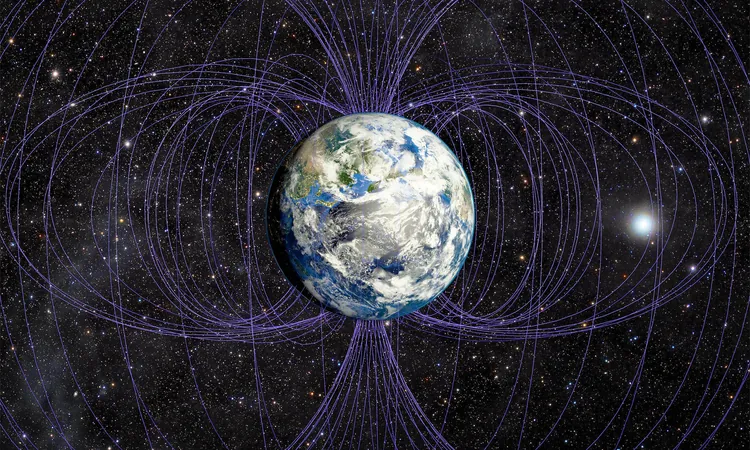
The Magnetic North Pole's Unexpected Shift: A Wake-Up Call for Navigation and Science
2024-11-24
Author: Kai
Understanding the Magnetic North Pole
Many people might not realize that the magnetic North Pole is far from a fixed point; rather, it continuously shifts due to the dynamic movements of molten iron within the Earth's outer core. This unique feature, which is distinct from the geographical North Pole, is crucial for navigation as it is where the Earth’s magnetic field points vertically downwards—the orientation that compass needles align with during navigation.
Historically, the magnetic North Pole has been a reliable reference, but its movements can disrupt navigation systems, necessitating regular updates to maps and compasses. Such disruptions carry real-world consequences, particularly for technology-dependent modes of transportation.
From Canada to Siberia: A Wyld Journey
In recent years, the magnetic North Pole has gained attention for its rapid migration. Initially located in northern Canada, the pole began its accelerated journey in the late 20th century. By the 1990s, it had crossed the Arctic Ocean, moving at rates that peaked at an astonishing 55 kilometers per year in the 2010s. Today, it is still charging toward Siberia at about 25 kilometers annually.
What is Behind This Rapid Movement?
The reasons behind such unusual behavior are debated among geophysicists. Renowned geomagnetic expert Dr. William Brown proposes several potential factors:
1. **Changes in Molten Iron Flow**: Variations in the flow of molten iron beneath the Earth's crust could be altering the magnetic field's strength and direction, which is crucial for the generation of the magnetic field.
2. **Solar Particle Interactions**: High-energy particles from solar events, such as solar storms and solar winds, interact with the Earth’s magnetosphere, potentially causing fluctuations in the magnetic field.
3. **Historical Magnetic Reversals**: The planet has a history of magnetic pole reversals that occur approximately every 200,000 to 300,000 years. The last significant reversal happened around 800,000 years ago, and current shifts may reflect processes related to these past events.
Implications for Modern Navigation
The implications of a shifting magnetic North Pole extend beyond scientific curiosity. Modern devices like smartphones, cars, and even military equipment depend on highly accurate magnetic readings for functionality. Any significant pole movement that exceeds timely updates to navigation models, such as the World Magnetic Model (WMM), could lead to widespread discrepancies in location tracking.
Staying Ahead of the Polar Shift
To address the challenges posed by the magnetic North Pole's movement, experts emphasize the need for proactive measures:
- **Regular Updates to Navigation Models**: Continually refining and updating the WMM is essential to account for the ongoing shifts of the magnetic pole.
- **Expanding Scientific Research**: Continuous monitoring and research into the dynamics of the Earth’s core are vital for anticipating future movements.
- **Public Awareness Initiatives**: Educating people on the implications of magnetic field changes will help societies adapt to potential disruptions.
The Future of Earth’s Magnetic Field
The magnetic North Pole's rapid shift is not merely a scientific curiosity; it provides critical insights into the Earth’s inner workings. The ongoing research in this field is crucial for understanding Earth's geodynamo— the mechanism driving our magnetic field that protects life on the planet by shielding it from harmful solar radiation.
Moreover, a shift could foreshadow the natural yet unpredictable process of magnetic pole reversal, which has occurred numerous times throughout Earth's history. Such reversals can temporarily weaken the magnetic field, exposing the planet to increased cosmic radiation, potentially detrimental to ecosystems and technology.
As scientists keep a watchful eye on the magnetic North Pole's movement, they continue to prepare for whatever challenges may arise from this profound natural phenomenon. The implications of these shifts remind us of the interconnectedness of technology and our planet's physical dynamics.
Stay tuned—because understanding the magnetic North Pole’s journey could shape the future of navigation and our interaction with the Earth itself.


 Brasil (PT)
Brasil (PT)
 Canada (EN)
Canada (EN)
 Chile (ES)
Chile (ES)
 España (ES)
España (ES)
 France (FR)
France (FR)
 Hong Kong (EN)
Hong Kong (EN)
 Italia (IT)
Italia (IT)
 日本 (JA)
日本 (JA)
 Magyarország (HU)
Magyarország (HU)
 Norge (NO)
Norge (NO)
 Polska (PL)
Polska (PL)
 Schweiz (DE)
Schweiz (DE)
 Singapore (EN)
Singapore (EN)
 Sverige (SV)
Sverige (SV)
 Suomi (FI)
Suomi (FI)
 Türkiye (TR)
Türkiye (TR)